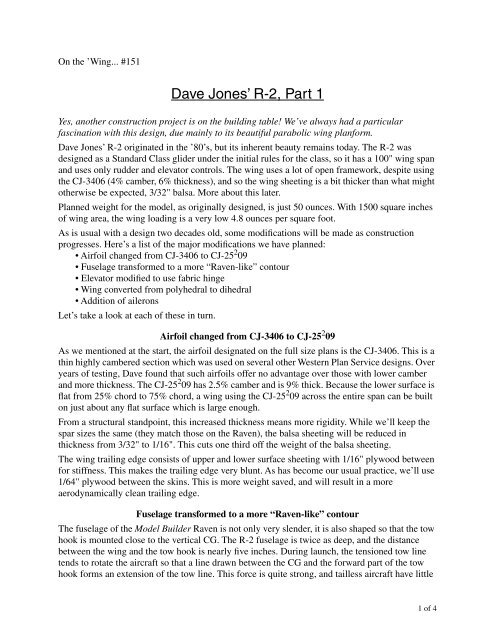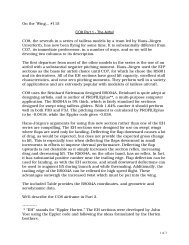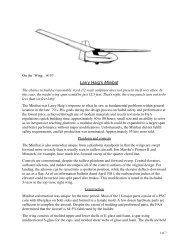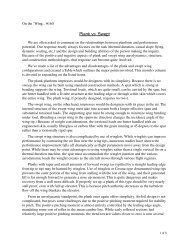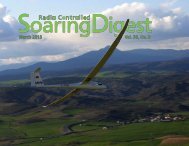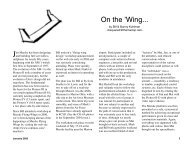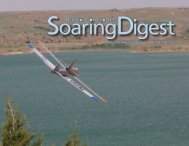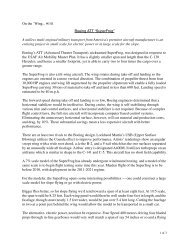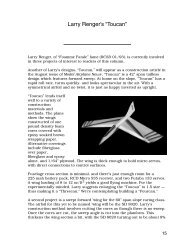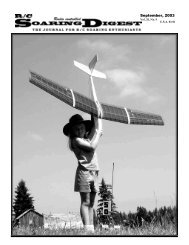Dave Jones' R-2, Part 1 - Radio Controlled Soaring Digest
Dave Jones' R-2, Part 1 - Radio Controlled Soaring Digest
Dave Jones' R-2, Part 1 - Radio Controlled Soaring Digest
Create successful ePaper yourself
Turn your PDF publications into a flip-book with our unique Google optimized e-Paper software.
On the ’Wing... #151<strong>Dave</strong> Jones’ R-2, <strong>Part</strong> 1Yes, another construction project is on the building table! We’ve always had a particularfascination with this design, due mainly to its beautiful parabolic wing planform.<strong>Dave</strong> Jones’ R-2 originated in the ’80’s, but its inherent beauty remains today. The R-2 wasdesigned as a Standard Class glider under the initial rules for the class, so it has a 100" wing spanand uses only rudder and elevator controls. The wing uses a lot of open framework, despite usingthe CJ-3406 (4% camber, 6% thickness), and so the wing sheeting is a bit thicker than what mightotherwise be expected, 3/32" balsa. More about this later.Planned weight for the model, as originally designed, is just 50 ounces. With 1500 square inchesof wing area, the wing loading is a very low 4.8 ounces per square foot.As is usual with a design two decades old, some modifications will be made as constructionprogresses. Here’s a list of the major modifications we have planned:• Airfoil changed from CJ-3406 to CJ-25 2 09• Fuselage transformed to a more “Raven-like” contour• Elevator modified to use fabric hinge• Wing converted from polyhedral to dihedral• Addition of aileronsLet’s take a look at each of these in turn.Airfoil changed from CJ-3406 to CJ-25 2 09As we mentioned at the start, the airfoil designated on the full size plans is the CJ-3406. This is athin highly cambered section which was used on several other Western Plan Service designs. Overyears of testing, <strong>Dave</strong> found that such airfoils offer no advantage over those with lower camberand more thickness. The CJ-25 2 09 has 2.5% camber and is 9% thick. Because the lower surface isflat from 25% chord to 75% chord, a wing using the CJ-25 2 09 across the entire span can be builton just about any flat surface which is large enough.From a structural standpoint, this increased thickness means more rigidity. While we’ll keep thespar sizes the same (they match those on the Raven), the balsa sheeting will be reduced inthickness from 3/32" to 1/16". This cuts one third off the weight of the balsa sheeting.The wing trailing edge consists of upper and lower surface sheeting with 1/16" plywood betweenfor stiffness. This makes the trailing edge very blunt. As has become our usual practice, we’ll use1/64" plywood between the skins. This is more weight saved, and will result in a moreaerodynamically clean trailing edge.Fuselage transformed to a more “Raven-like” contourThe fuselage of the Model Builder Raven is not only very slender, it is also shaped so that the towhook is mounted close to the vertical CG. The R-2 fuselage is twice as deep, and the distancebetween the wing and the tow hook is nearly five inches. During launch, the tensioned tow linetends to rotate the aircraft so that a line drawn between the CG and the forward part of the towhook forms an extension of the tow line. This force is quite strong, and tailless aircraft have little1 of 4
forward of the inboard edge of the control surfaces. This has worked extremely well for us in thepast.This is an exciting construction project for us, as we’re updating a beautiful design without goinghigh-tech. In fact, some of the construction methods are straight from old free flight techniques. Itwill be a learning experience, that’s for sure.This will be a four part series. We’ll get the wing and elevator completed in <strong>Part</strong> 2, and in <strong>Part</strong> 3we’ll construct the fin and the fuselage. In <strong>Part</strong> 4 we’ll describe ’glassing, painting, and covering(yes, we already have the colors picked out), plus, of course, the flying!We’re always eager to hear about readers’ projects. If you’ve built or are building somethingwhich you think may be of interest to other RCSD readers, please let us know. We’re also on thelookout for suggestions for topics for future “On the ’Wing...” columns. Contact us at P.O. Box975, Olalla WA 98359-0975 USA or by e-mail at .R-2 SpecificationsSpan100 inchesRoot chord 17"Wing areaAirfoilSweepConstruction:• Wing• Elevator• Fuselage• Fin and rudderWeight, projectedWing loading1500 sq. in.CJ-3406Apex of wing tip set back 12.75" from leading edge at root• Balsa ribs, spruce spar caps with balsa webbing, 3/32" balsasheeting, 1/8" sq. spruce turbulator spars, and 1/16"plywood trailing edge core• Balsa ribs and sheeting• Plywood sides, balsa block upper and lower• Open framework of balsa ribs with sheeting on root panel offin, plywood trailing edge50 ounces4.8 oz. per sq. ft.3 of 4
4 of 4


